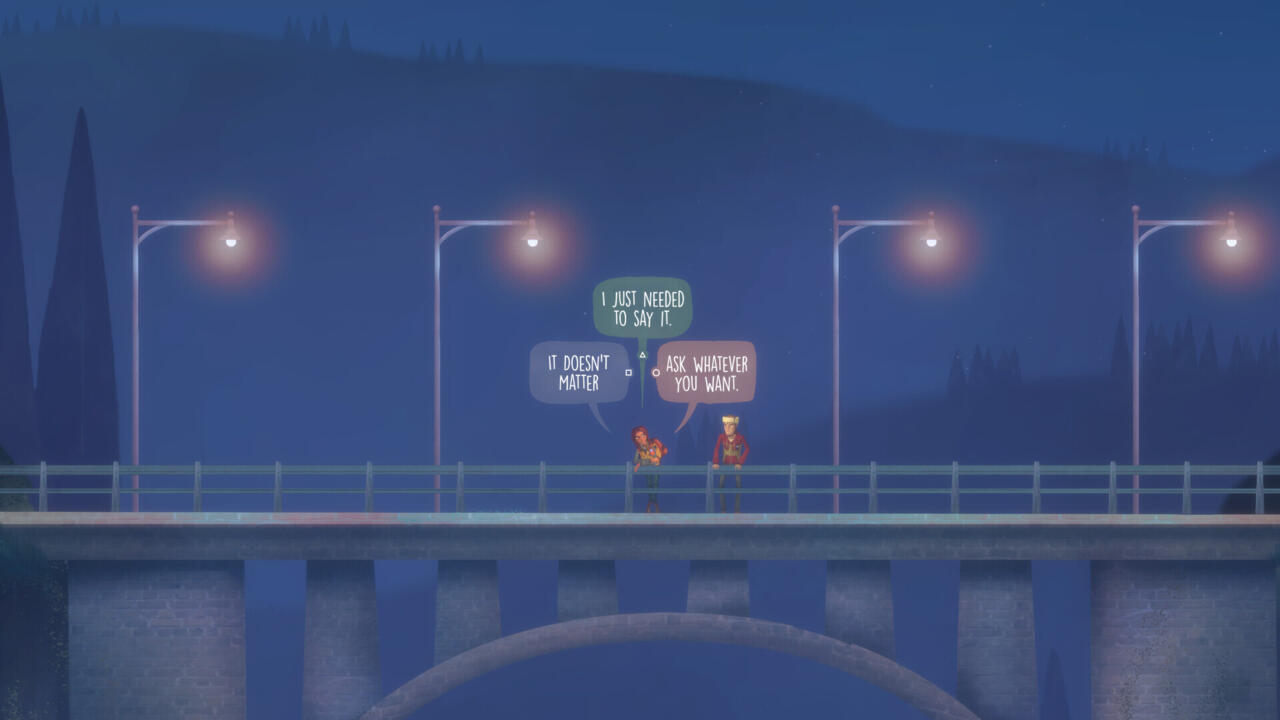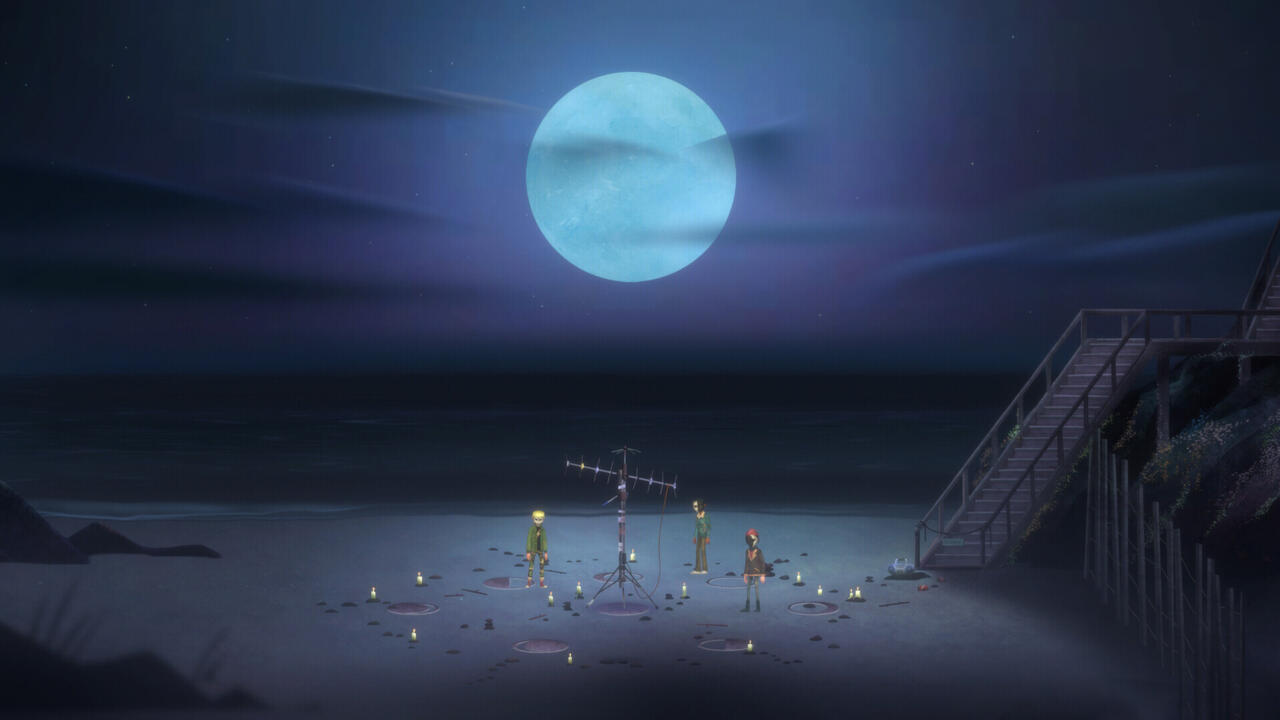Oxenfree II: Lost Signals is quite creepy at times, using time loops, crackling radio static, and the occasional vengeful interdimensional ghost to keep you on your toes. Sure, there are moments of levity when the game's characters crack jokes or dabble in a little fun but, like its 2016 predecessor, this dialogue-driven graphic adventure game delights in its unsettling atmosphere. The best parts of the experience are drowned out in the dreadful static of Oxenfree II's unmemorable companion and irritating secondary antagonist, but navigating the game's growing sense of unease as you slowly uncover clues to a greater mystery is an engaging and chilling thrill.
Taking place five years after the original game, Oxenfree II has you play as a new protagonist: Riley Poverly. Returning to her hometown of Camena--the part of the mainland closest to the first Oxenfree's Edwards Island--Riley is partnered with the town's resident handyman, Jacob Summers, and tasked to set up transmission radio towers around the coastal town. The seemingly simple job devolves into a much stranger and more dangerous situation, however, as electromagnetic waves take a toll on reality, opening portals to other timelines. As Riley and Jacob struggle to understand what's happening and fix things, they find their efforts repeatedly thwarted by a trio of teenagers who are a part of Parentage, a church-like cult in the area, and lingering supernatural specters.

Like its previous games, developer Night School Studio utilizes both a choice- and timing-driven dialogue system, taking note of not only what you say but when you say it. Conversations don't pause to give you a chance to figure out what to say next--like an actual conversation in real life, Riley will have to regularly respond to express interest. During conversations, small thought bubbles will appear above Riley's head as people talk to her, giving you a chance to choose how you speak your mind. Wait too long and these dialogue branches eventually fade away, but speak up too soon and you may interrupt someone just before they absent-mindedly say something that creates a more compelling path in the conversation. In this way, saying nothing at all is just as valid a choice as saying something.
The main crux of Oxenfree II is Riley's walkie-talkie, which allows her to stay in regular contact with several characters across Camena, like a park ranger trying to understand the supernatural stuff that's happening and a lonely old fisherman looking for a friend. It's through this walkie-talkie that a great deal of Oxenfree II's conversations occur, and being strategic in how and when you talk can drastically alter the relationships that Riley has with these characters and the ultimate conclusions to their stories.
Forging these relationships with what are essentially just voices is the strongest element of Oxenfree II. Compelling writing and a talented voice cast bring these characters to life, and navigating their fledgling friendships through the pressure cooker of a single night of terrifying supernatural activity gets you deeply invested in each one. Riley's regular check-ins and conversations about family with her supervisor Evelyn are especially good and feel increasingly poignant to the game's themes about priorities and finding the strength to move forward in life. (Someone, somewhere needs to give actors Liz Saydah, aka Riley, and Alaina Wis, aka Evelyn, all the awards for how well they bring their characters to life.)

There's also something especially unnerving about never seeing most of the people that tether Riley to her current reality, lending further support to the game's themes of isolation. Not providing a face for most of the characters is doubly disquieting when it comes to the main antagonists of the game, ghosts who communicate with Riley from another dimension by splicing together their sentences with phrases and words from different radio broadcasts. Occasionally, they'll gnaw at the festering wounds of Riley's trauma as well, pulling her into visions of the past and future so that she can relive the deterioration of her family life and witness how she pays that generational trauma forward to future generations. Rarely does Oxenfree II go for the jump scare, and the game is stronger for it, building up the unsettling presence of its villains by not giving them a tangible face or easily understood motivation until the very end of the game.
Oxenfree II does an incredible job building up the tenuous grasp that Riley has on reality and her desperation in needing her walkie-talkie both as the one major lifeline to her support network and the best way to keep tabs on the voices who want to kill her. So it's baffling that the game then undermines that with additional allies and antagonists who Riley does get to see and put a face to. Riley is regularly accompanied by Jacob, who graciously fills the otherwise dead air while walking back and forth across the map with conversation. However, these conversations are oftentimes boring or, worse, unfunny and cringy. I get the sense that Jacob is meant to be a moral indicator for you, with his behavior and characterization evolving in reflection of how he sees you treat others and him over the course of the game. But this leaves Jacob feeling more like a lost puppy dog than an actual person, his repeated pleas for Riley to validate his life choices growing increasingly irritating over time. By the two-hour mark, I wanted to toss him down a cliff.
Olivia, the leader of the trio of teens who serve as the secondary antagonist, isn't as bad as Jacob, though I suspect that's largely because she only pops up in brief moments in the story. The trio's tenuous grasp of the multidimensional ghosts haunting Camena also provides the terrifying yet thrilling opportunity for the game's villains to enact physical damage on the world, not just mental or emotional. Plus, it's easier to discern how your choices are influencing Olivia and her friends, with your actions in regard to all three having major ramifications in the game's two most climactic moments. Olivia's presence lends greater emotional weight to your decisions, rewarding however you want to play Riley with tangible effects on the direction of the story and its overall conclusion. That said, Olivia isn't all that interesting of an antagonistic force, especially in comparison to the dark masters she serves, coming off as snobbish, spiteful, and mean-spirited.

In spite of these shortcomings, Oxenfree II is still a good game, building on how the first Oxenfree explored someone coming to terms with their guilt in their teenage years to now tackle those same themes from an adult's perspective. Riley is struggling with how her own self-loathing and guilt have left her life feeling static, the voice of past traumas preventing her from moving forward during a period when she feels she needs to. It feels narratively apt that the only way she's able to take that next step forward and do what's best for her is to literally cut through the voices within radio static that's threatening the hometown where she grew up and most of her trauma started. It's a simple metaphor, but it's effective and instantly relatable, especially for anyone feeling a bit stuck in life in their early 30s.
The sound design for this game is absolutely killer. Games that aim for a spooky atmosphere live and die by their sound design, and Night School Studio expertly utilizes barely discernible undertones throughout to create the sensation that something supernatural is in the air all around you. I'm of the opinion that a radio is one of the creepiest devices you can put into a thriller or horror game given the strange, almost alien reverberating voices that cascade through the hissing static as you navigate between channels. Those sounds populate Oxenfree II from start to finish like a dying voice trying to claw its way back into our reality. It's just a shame Jacob keeps breaking the tension with his terrible jokes and unremarkable tangents.
Oxenfree II is a strong sequel to the original game. A particular secondary character and antagonist drag the experience down a bit but the overall storyline is a satisfying foray into an adult woman's tenuous grasp on reality and her ultimate decision to cut through the static and strive for something better with the help of the friendships forged whilst speaking over a simple walkie-talkie.